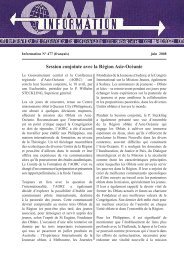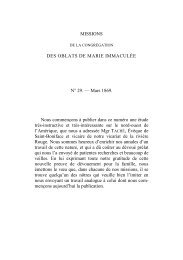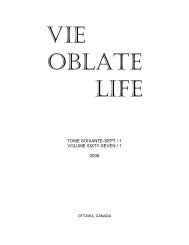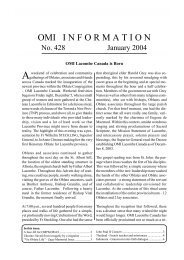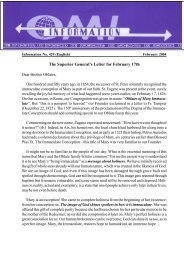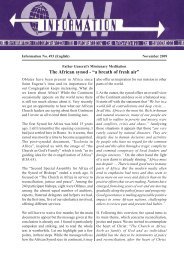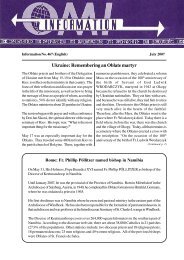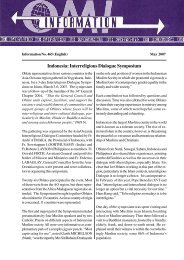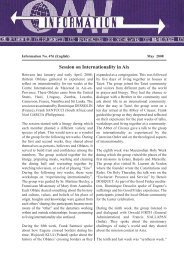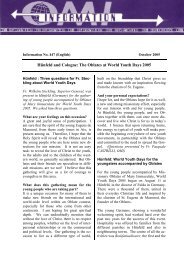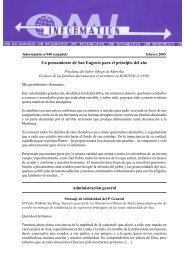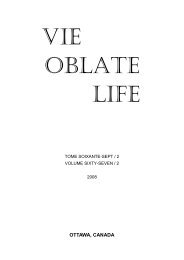Download - Missionary Oblates of Mary Immaculate Communications
Download - Missionary Oblates of Mary Immaculate Communications
Download - Missionary Oblates of Mary Immaculate Communications
You also want an ePaper? Increase the reach of your titles
YUMPU automatically turns print PDFs into web optimized ePapers that Google loves.
455/8 June 2006Asia-OceaniaPAKISTANStudy Seminars in the formation housesIn Lahore, the philosophy students have begun gatheringfor a monthly informal exchange on philosophicalquestions. They call it Philosophy Chowk. Forthose not initiated in the Urdu or Punjabi languages,a chowk designates a round-about for city traffic.The philosophy students use this word to describetheir gatherings much as French speaking communitiesspeak <strong>of</strong> “un carrefour” and English-speaking,a “round-table.”At the theology house in Karachi, the scholasticsare still looking for a name for their seminars combiningOblate studies and social analysis. They beganby calling the seminars: “Oblate Integration: Studyand Action.” However, the name is cumbersome inits attempt to capture the various elements <strong>of</strong> thegoal. The seminars will meet about three times eachyear. The first one was launched in April; its subjectwas the Oblate Mission for Christian-Islamic Dialogue.Presentations were <strong>of</strong>fered relating to: 1) recentOblate Chapter documents on Evangelization andInculturation, 2) the Federation <strong>of</strong> Asian Bishops’Conference’s perspectives on dialogue with Islam,and 3) the present Muslim reality in Pakistan and inthe world and its challenge to the mission <strong>of</strong> interfaithdialogue.In a first phase <strong>of</strong> discussion, the participants sharedtheir own experience <strong>of</strong> the Islamic world and theirgenuine feelings on the prospect <strong>of</strong> dialogue withsuch an imposing giant. From the sharing, it wasobvious that Christians in Pakistan have not enteredthe first step <strong>of</strong> dialogue, understandably, because<strong>of</strong> the abuses experienced in a minority-oppressivecontext.In a second meeting Father Vernon DERRICK ledthe search for interpretation and directions for action.He highlighted important values and indicatedsome areas where relevant action may be taken.Future Oblate mission seminars will adopt a methodologythat includes study, analysis, personalawareness, and decisions for action. The conversationswill follow four phases: 1) gathering <strong>of</strong> data(information), 2) sharing <strong>of</strong> personal reactions andfeelings, 3) interpretation: reflections on theologicalmeaning and values, 4) practical applications:decisions and action.PHILIPPINESDouble celebration at Our Lady <strong>of</strong> GraceParishThere was great jubilation and excitement in the faces<strong>of</strong> Our Lady <strong>of</strong> Grace parishioners on February 18as they marked two great events: the public proclamation<strong>of</strong> the new Vision Statement <strong>of</strong> the parish inCaloocan City, and the blessing <strong>of</strong> the St. Eugenede Mazenod Community Center. The celebrationstarted with the Eucharist presided by BishopDeogracias Iniguez, with <strong>Oblates</strong> concelebrating. TheFilipino Oblate Provincial, Fr. Ramon BERNABEhighlighted the significance <strong>of</strong> the twin events in hishomily.After the homily, the chairperson <strong>of</strong> the Parish PastoralCouncil, Mr. Danny Sanchez, led the parishionersin the ritual proclamation <strong>of</strong> the Vision Statement.The forward-looking and daring vision wasratified by the 430-strong Parish General Assemblyjust the night before. The assembly was precededby four months <strong>of</strong> intensive consultation among theparishioners.At the end <strong>of</strong> the Mass, the people went in processionto the front <strong>of</strong> the new building for the blessing.The inspiring statue <strong>of</strong> St. Eugene de Mazenod wasunveiled by Mayor Enrico Echiverri <strong>of</strong> CaloocanCity. He later spoke <strong>of</strong> the new building as a newlandmark in the city.The new building has eight mortuary chapels to servethe needs <strong>of</strong> the community. The chapels have beennamed after deceased <strong>Oblates</strong>—Bishops Ben DEJESUS and Antonino NEPOMUCENO, FathersBenjamin INOCENCIO, Primo HAGAD, EnriqueGONZALES, Edward GORDON, JosephMILFORD, and. William MCGRATH. The buildingalso houses the MAMI <strong>of</strong>fice, 5 medical-dentalclinics, the Kiddie Learning Center, the VocationalTraining School, and conference rooms for the parish.(Taddy CASTILLO, www.omiphil.org)



